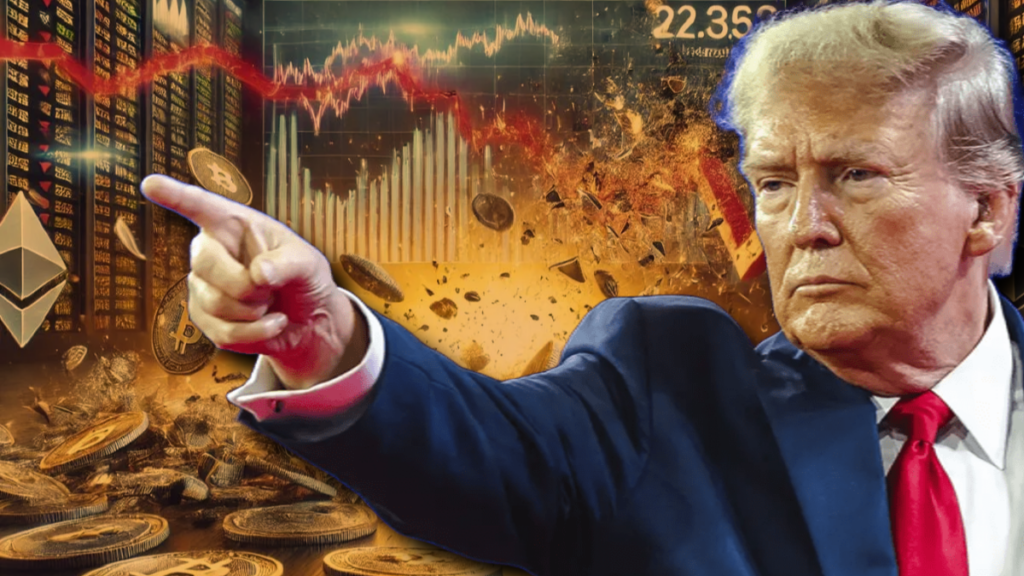Tariff Shock: Policy Decision Reopens Global Risk Channels
In a move that blindsided global markets, former U.S. President Donald Trump, now a major political figure in the 2024 elections, announced a sweeping 10% tariff on imports from key economies including China, the European Union, and India. This protectionist pivot—positioned as a recalibration of America’s trade stance—triggered immediate market repricing and reignited concerns over a new wave of trade hostilities.
With global financial systems already contending with inflationary pressures, tightening credit conditions, and geopolitical fragmentation, this development has amplified volatility across equities, currencies, and commodities.
Market Response: Broad-Based Sell-Off and Wealth Destruction
The announcement wiped out over $5 trillion in global equity value in mere trading sessions. Key U.S. benchmarks fell sharply:
- Dow Jones lost 2.3%.
- S&P 500 declined 2.1%.
- Nasdaq Composite dropped 2.5%.
This steep sell-off reflects not only the direct revenue and supply chain impacts for global multinationals, but also a resurgence in risk aversion, particularly in sectors with high trade exposure—automobiles, semiconductors, and industrials.
India Takes a Hit: Wealth Destruction and Currency Pressure
India, a rising economic powerhouse and a pivotal player in global IT and pharmaceutical supply chains, bore the brunt of the market reaction in Asia:
- Sensex declined 2,500+ points.
- Nifty 50 breached the psychological 21,000 mark.
- Investor wealth eroded by ₹19 lakh crore (~$230 billion USD).
The INR weakened, increasing pressure on import costs and fiscal stability. Indian corporates with significant U.S. revenue exposure saw disproportionate drawdowns, leading analysts to recalibrate FY26 earnings outlooks.
Asia-Pacific Under Stress: Export Economies Retrench
Trade-heavy Asian markets recorded some of the steepest declines in recent memory:
- Nikkei 225 fell 9% week-over-week.
- Hang Seng slid 13.2%.
- TAIEX dropped 9.7%.
- KOSPI and ASX 200 followed suit.
Semiconductor and electronics firms led the retreat, given their dependency on cross-border production ecosystems and U.S. consumer demand. Analysts note a risk of downward revisions in capex forecasts if tariff tensions persist into Q2.
European Equities Slide Amid Fears of Retaliation
Europe’s major indices weren’t spared:
- Germany’s DAX declined 6%, with automakers under severe pressure.
- CAC 40 and FTSE MIB also posted multi-point losses.
- The FTSE 100 dropped 6%, reflecting broader European vulnerability.
As speculation mounts over retaliatory tariffs from the EU Commission, investor appetite for European industrials and exporters has contracted sharply.
Middle East: GCC Equities Hold Steady on Energy Tailwinds
Interestingly, Gulf Cooperation Council (GCC) markets were notably resilient. The TASI (Saudi Arabia) index posted modest gains, supported by strong oil revenue buffers and lower exposure to goods targeted by the U.S. tariffs. Nonetheless, the potential for second-order effects—particularly in energy demand—remains on the radar.
Flight to Safety: Classic Havens Rally
Investors rotated heavily into defensive assets:
- Gold approached $2,300/oz.
- U.S. Treasury yields dropped below 4% on increased demand.
- Cryptocurrencies posted mixed reactions, reflecting short-term speculative flows.
- Brent and WTI crude fell slightly on anticipated demand softening.
The collective shift underscores deep market unease and a search for stability amid escalating policy uncertainty.
Macro Themes: Slower Growth, Repricing Risk, and Inflation Persistence
This tariff escalation feeds into broader macroeconomic concerns:
- Stagflation Risk: Higher import costs may revive inflationary pressures even as growth slows.
- Supply Chain Vulnerability: Re-globalization trends may pause or reverse, raising input volatility.
- Policy Divergence: Central banks could face diverging mandates—taming inflation versus cushioning demand.
- Capital Outflows: Emerging markets may witness renewed portfolio rebalancing and FX depreciation.
Asset managers and hedge funds are expected to revise global allocation strategies in light of these developments.
Investment Implications: Navigating the Shockwave
1. Repricing Risk Across Sectors
Expect margin compression in industries highly exposed to imports—apparel, electronics, automotive—and those reliant on U.S. consumption.
2. Currency Volatility Ahead
Expect heightened FX hedging activity, especially in EM currencies facing twin deficits (India, South Africa, Turkey).
3. Shift Toward Quality and Liquidity
Institutional flows may favor large-cap, cash-rich firms with pricing power and domestic demand insulation.
4. Defensive Positioning
Sectors such as utilities, healthcare, and select consumer staples may outperform amid volatility.
Outlook: Tactical Hedging Meets Strategic Reallocation
While markets may partially recover once policy details and enforcement timelines are clarified, the broader signal is clear: geopolitical risk premiums are back on the table.
For asset managers, this is a moment to diversify exposures, stress-test portfolios, and embed geopolitical scenarios into forward-looking asset allocation models.
For policymakers, the urgency lies in preventing a tit-for-tat spiral that undermines investor confidence and disrupts the fragile post-COVID economic recovery.

